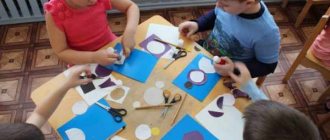MAGAZINE Preschooler.RF
Consultation “The importance of didactic games in the labor education of preschool children”MUNICIPAL BUDGET PRESCHOOL EDUCATIONAL INSTITUTION KINDERGARTEN No. 7 COMBINED TYPE
Educator: Orlova A.A. Cuban, 2019
“Children should be raised not for happiness, but for work - this will bring them happiness.”
K.D. Ushinsky.
In accordance with the Federal State Educational Standard, labor education is one of the important areas in the work of preschool institutions.
Relevance:
Labor education is an important means of comprehensive development of the personality of a preschooler through familiarization with the work of adults and introducing children to accessible work activities. Raising the younger generation to be hardworking has always been the primary task of all educational institutions.
The problems of labor education are quite relevant for preschool children, since at this stage the child develops personal qualities, skills and desire for work.
Hard work is most successfully developed in preschool age. Their lack of formation at this age stage becomes an obstacle to educational and cognitive activity and subsequent adaptation to independent work.
The purpose of labor education is to lay the foundations for a positive and value-based attitude towards work as a primary human value.
Objectives of labor education:
- Fostering a positive attitude towards the work of adults, the results of their work, the desire to provide all possible assistance;
- Formation of work skills and personal qualities in children (to finish what they start, conscientiousness, responsibility);
- Formation of positive relationships between children in the process of work;
- Training in organization and work culture.
For preschool children, the main activity is play. Play is the most important means of development, training and education of preschool children. Many games develop in children respect for the working person, arouse adults to work, and the desire to work themselves.
The main types of games where children get acquainted with the work of adults are:
- plot-role-playing game - a game in which children play out an imaginary situation. The situation is made up of plot and roles;
- theatrical game - a game in which children act out a plot from a literary source.
- a didactic game is an educational game.
Didactic games are a type of games with rules, specially created by pedagogy for the purpose of raising and teaching children.
The importance of didactic games is extremely great: in the process of gaming activities, the comprehensive development of the child’s personality occurs. Didactic games are a means of education; with their help, the teacher influences all aspects of the child: will, consciousness, feelings, relationships. Perform a teaching function. They are a means of initial education for preschoolers. In them, children reflect the life around them and learn facts and phenomena that are understandable to them.
In relation to labor education, didactic games are aimed at solving specific problems of teaching children (they contribute to the assimilation, expansion, consolidation of children’s knowledge about work, objects of work, materials, tools and equipment needed by people of different professions, about the variety of professions of adults), but in at the same time, an educational and developmental influence is manifested in them: the development of higher mental processes occurs, a respectful attitude towards working people, the professions of parents, a value-based attitude towards one’s own work, and the desire to realize oneself in one or another field of activity are formed.
In preschool pedagogy, didactic games are divided into four main types:
- Games with objects
- Board and printed games
- Word games
- Computer games.
Let's consider these types of games through the prism of labor education. So,
Games with objects
Toys and real objects are used here; by playing with them, children learn to compare, establish similarities and differences between objects.
To solve the didactic problem - getting to know the professions of adults, games with objects are used such as: “Kindergarten” (wooden builder, dishes, bed linen, etc. - children choose from a variety of different objects); “Builder” (from a variety of objects, children choose those that can be seen at a construction site - toy ones - a brick, a crane, a tractor). “Assemble a hairdresser’s kit” (toy scissors, combs, hair dryer, hairspray, curlers - children choose from a variety of different items). Children also interact with dolls wearing clothes of people from different professions. While playing with them, children analyze and draw conclusions why a person of a particular profession needs this type of clothing. For example, why does a builder need a helmet? Does the cook need an apron and cap? At a younger age, the doll is used to develop sensory-motor and basic labor skills (self-service) in children.
Board and printed games
Types of board and printed games:
- Selection of pictures in pairs. The simplest task in this game is to find two completely identical ones among different pictures. Gradually the task becomes more difficult. The child combines pictures not only by external features, but also by meaning. For example, given 3 pictures with the image of Aibolit, in one of them there is no briefcase in the doctor’s hands, children must choose two other pictures.
- Selection of pictures based on common characteristics. A connection is established between objects. For example, “What does the doctor need?”, “What does the hairdresser need?”, “What is in the store,” etc. Children select pictures with corresponding objects.
- Selection of pictures to remember the composition, number of pictures arrangement. For example, in the game “Guess which picture was hidden?” Children must remember the contents of the pictures and then name the one that will be removed from the table. This type effectively promotes memory development. Pictures are selected in accordance with a particular profession.
- Making cut pictures and cubes. To solve the didactic task of getting to know the professions of adults, these pictures can be on topics of various professions. This type effectively promotes the development of logical thinking in children.
- Description, story about the picture showing actions, movements. Objectives: development of children's speech, imagination, creativity. For example, the game “Guess who it is?” The child depicts the sound and movement of what is planned.
Word games
Didactic games are built on the words and actions of the players. In such games, children learn, based on existing ideas about objects, to deepen their knowledge about them, because Such games require the use of previously acquired knowledge. Children independently solve a variety of mental problems. They describe objects, guess from the description, find signs of similarities and differences, group objects according to various criteria. Example: game “Crocodile” (Using gestures and facial expressions, show the proverb).
- Labor feeds a person, but laziness spoils him.
- What goes around comes around.
- You can't catch a fish from a pond without difficulty.
- Who does not work shall not eat.
Game “Finish the proverb, saying .
- Less words, more action.
- The eyes are afraid, but the hands are doing.
- Finished the job - go for a walk safely.
Computer games are games played on an interactive whiteboard or personal computer.
Computer didactic games are used to improve the quality of education.
Continuous duration of work with a computer in the form of educational games for children 5 years old should not exceed 10 minutes and for children 6 - 7 years old - 15 minutes.
The interactive whiteboard can only be used as additional technical equipment for short-term use in classes and for demonstrating certain educational materials. According to SanPiN, we can use ID every day only in 1 lesson and no more than 2 - 10 minutes, depending on the age of the children.
After playing computer games, it is necessary to do eye exercises.
When organizing a didactic game, you must follow a number of rules:
— The teacher has certain knowledge and skills regarding didactic games.
- Expressiveness of the game. This ensures children's interest, desire to listen, and participate in the game.
-The need to include the teacher in the game. He is both a participant and the leader of the game. The teacher must ensure the progressive development of the game in accordance with educational and educational objectives, but at the same time not exert pressure, play a secondary role, and, unnoticed by the children, direct the game in the right direction.
-It is necessary to optimally combine entertainment and learning. When conducting a game, the teacher must constantly remember that he is giving children complex educational tasks, and the form of their implementation turns them into a game - emotionality, lightness, ease.
-Means and methods that increase children’s emotional attitude towards play should be considered not as an end in itself, but as a path leading to
fulfillment of didactic tasks.
-There should be an atmosphere of respect, mutual understanding, trust and empathy between the teacher and children.
-The visualization used in the didactic game should be simple and succinct.
-Competent conduct of didactic games is ensured by clear organization of didactic games. First of all, the teacher must understand and formulate the purpose of the game, answer the questions: what skills and abilities will children master during the game, what moment of the game should be given special attention, what educational goals are pursued when playing the game? We must not forget that behind the game there is a learning process. And the teacher’s task is to direct the child’s energy to study, to make the serious work of children entertaining and productive.
-Next, you need to decide on the number of players. Different games have different numbers of them. If possible, we should strive to ensure that every child can participate in the game. Therefore, if some children carry out gaming activities, then the rest should play the role of controllers, judges, that is, also take part in the game.
-The next important step in organizing a didactic game is the selection of didactic materials and aids for the game. In addition, you need to clearly plan the timing of the game. In particular, how to introduce children to the rules of the game in the least amount of time. It is necessary to foresee what changes can be made to the game in order to increase the activity and interest of children, and to take into account the possible occurrence of planned situations when conducting didactic games.
And finally, it is important to think through the conclusion, summing up after the didactic game.
Thus, a well-organized didactic game is the most important means of labor education for preschoolers.
| Next > |
Didactic games on manual labor
Marina Revina
Didactic games on manual labor
Didactic game "Atelier".
Program content: continue to introduce children to the properties of the materials from which things are made; help you remember and independently determine some properties of the fabric; activate the corresponding dictionary; learn to select fabric for different types of clothing.
Material: thick paper envelopes with slits on the front wall. The slots reproduce the contours of various garments. Scraps of fabric of different textures and colors (silk, chintz, satin, staple, crimplene, wool, drape, lace).
Didactic exercise “Globules”.
Program content: learn to wind threads evenly into a ball; develop fine motor skills; consolidate children's knowledge of what and how woolen threads are made from; cultivate accuracy and patience.
Material: wool threads.
Didactic exercise “Collect beads.”
Program content: introduce children to the properties of the materials from which beads are made; develop imagination; consolidate children's knowledge of the names of colors and shades; teach how to collect beads of the same color and size (or alternating the color and size of beads); cultivate neatness.
Material: fishing line, various beads, differing in color, shape, size.
Didactic exercise “Dress the dolls for a walk.”
Program content: practice using the names of colors and color shades, by developing the ability to combine colors, work with shape; develop imagination, taste; cultivate a caring attitude towards the materials used.
Didactic exercise “Journey through the labyrinth.”
Program content: learn to guide a small ball or bead through a fabric labyrinth; develop fine motor skills; cultivate perseverance.
Material: two pieces of fabric of the same size. Both parts of the fabric are stitched along the edge, and a labyrinth is stitched, on which holes are left for the entry and exit of the ball.
Didactic exercise “Balloons”.
Program content: strengthen children's ability to tie knots; develop imaginative thinking; learn to divide threads into sewing, embroidery, knitting, darning; learn to tie cords in a checkerboard pattern; cultivate a caring attitude towards the materials used.
Material: wooden plank with cords attached to it.
Didactic exercise “Multi-colored rug.”
Program content: learn to weave strips of colored oilcloth into the base in a certain order; develop fine motor skills of the hand; introduce children to working on a loom; develop an interest in working with your hands.
Material: a rectangular base with slots made parallel to each other at equal distances, as well as identical strips cut from colored oilcloth in a contrasting color to the base.
Card index of labor education games for children 5–7 years old
Tatiana Pevneva
Card index of labor education games for children 5–7 years old
CARD INDEX
on labor education
for children 5-7 years old
Target. children's ideas about objects and their use in labor processes . Introduce professions.
Progress of the game:
The teacher names the objects , and the children name the profession of the person who needs them. For example: scissors, telephone, stretcher, nails, cash register, pencil, brush, tray, bell.
It should be borne in mind that the same items are needed by people of different professions. For example, a rope is needed by athletes, sailors, builders, and rescuers.
"Guess what I'm doing?"
Target. Expand children's understanding of labor activities . Develop attention.
Progress of the game:
The teacher and children join hands and stand in a circle. A child comes to the center of the circle. Everyone walks in a circle and says:
We don’t know what you’re doing,
Let's take a look and guess.
The child imitates labor actions not only with movements, but also (if possible)
conveying sounds. For example, he cleans the floor with a vacuum cleaner, hammers a nail, saws, drives a car, does laundry, carries a bucket of water, wipes a mirror, chops wood, grates, turns something in a meat grinder, etc.
Children guess the actions.
“Let’s set the table for the dolls”
Target. Teach children to set the table , name the items needed for reference. Introduce the rules of etiquette (meeting guests, accepting gifts, inviting people to the table, behavior at the table). To foster humane feelings and friendly relationships.
Progress of the game:
The teacher addresses the children on behalf of Masha (bibabo doll)
:
- Masha asks me for a basin, a bucket of water and soap.
Submits the objects she calls to the doll.
- What do you think she will do? (Wash.)
Right.
And now Masha asks to give her a saucepan, milk, sugar, salt and millet. What is Masha going to do? (The doll wants to cook porridge.)
What is the name of the porridge?
(Millet.)
Other work activities that require appropriate items can be considered in a playful form. The kids are shown these items (an iron and a stack of doll's laundry - for ironing; a bucket and a watering can - for watering the beds, etc.).
When conducting this game with older children, the teacher uses pictures depicting objects corresponding to a particular type of work , or simply lists these objects (without showing illustrations, asking the children to guess more complex labor processes . For example: scissors, colored paper, glue, ruler, pencil - gluing books, repairing boxes, paraphernalia.
The game can be complicated: one child draws objects on the board, and the rest of the children guess the type of work , or all children simultaneously draw on paper, and then show the drawings to each other and guess.
Target. To give children a basic understanding of the professions of people work was not in the sphere of their observations. Arouse interest in the work of people of any profession.
Progress of the game:
The teacher shows the children pictures depicting the stages of replanting indoor plants and asks them to arrange them in the order in which the actions are performed.
• A pot is overturned and the plant is removed from it.
• Laying pebbles at the bottom of the pot.
• Pour sand into a pot (height 1 cm)
.
• Pour some soil into the pot on top of the sand.
• Shaking off old soil from the roots of the plant with a stick.
• Cutting off rotten roots.
• Planting the plant in a pot so that the transition point between the stem and the root is on the surface, and covering it with soil.
• Installing a pot with a plant on a pallet.
• Watering the plant at the root.
Target. Teach children to correctly name people's professions by the types of cars they drive.


